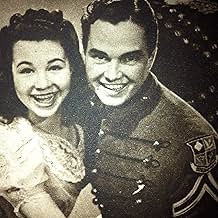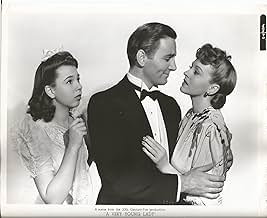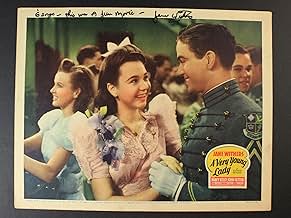AVALIAÇÃO DA IMDb
5,6/10
55
SUA AVALIAÇÃO
Adicionar um enredo no seu idiomaTomboy is sent to finishing school where she falls for the headmaster. When her love letters are discovered she okays his relation with a teacher and gets her first kiss from a beau.Tomboy is sent to finishing school where she falls for the headmaster. When her love letters are discovered she okays his relation with a teacher and gets her first kiss from a beau.Tomboy is sent to finishing school where she falls for the headmaster. When her love letters are discovered she okays his relation with a teacher and gets her first kiss from a beau.
Eddie Acuff
- Sheriff Bill Stone
- (não creditado)
William Edmunds
- Abner
- (não creditado)
Jackie Hughes
- Carver Cadet
- (não creditado)
Roger McGee
- Tough Boy
- (não creditado)
Dorothy Moore
- Miss Clayton
- (não creditado)
- Direção
- Roteiristas
- Elenco e equipe completos
- Produção, bilheteria e muito mais no IMDbPro
Avaliação em destaque
I watched this to compare it with Girls' Dormitory (1936) as both films are based on Ladislas Fodor's play Matura. The earlier film stars Herbert Marshall, Simone Simon and Ruth Chatterton. This later adaptation stars John Sutton, Jane Withers and Nancy Kelly. The essential plot is that a student at a finishing school, as well as one of the teachers, are both in love with the principal. He's oblivious to both of their affections.
In A Very Young Lady (1941) Jane Withers is Kitty Russell, a tomboy who has been sent to finishing school to develop some airs and graces. She gets into scraps with local lads, dressing as a boy with her face all smudged, before a teacher helps her with a duckling-to-swan transformation for the school dance. The reaction of principal Dr. Franklin Meredith (a very handsome John Sutton) to the transformation - "you're the prettiest girl in the school!" - requires some suspension of disbelief.
At this point Kitty develops a huge crush on Dr. Meredith. "Thirty? Oh my goodness! Why, he's an old man!" her friend Madge comments.
Kitty writes fantasy love letters to Dr. Meredith. These are discovered by another teacher, who thinks she is having a surreptitious and forbidden relationship with a local boy. Grilled by Dr. Meredith, Kitty can't bring herself to tell him the truth. She runs away and he comes to find her. And then she starts to reveal her heart in an excruciating scene that descends into hysterical laughter/tears, but Dr. Meredith still doesn't twig that he's the object of her adoration.
A Very Young Lady (1941) is more faithful to the original play in terms of its comedic aspects (Matura is described as "A Comedy") and also in terms of who ends up with whom. Girls' Dormitory (1936), described as a "romance", has a few comedic moments but is essentially a romantic melodrama. Withers was about 14 or 15 and very much a character actress when she played the ingenue role, whereas Simon was 25/26 and an alluring starlet.
Compared with Girls' Dormitory (1936) and probably the original play, there's no European flavour here: it's very Americanised. There are dates and motorcycles, milkshakes and drugstores, sheriff, pins and corsages. Lots of teenagerhood: these are very much kids, not so much young ladies ready for society and marriage upon graduation. It actually reminded me far more of another Herbert Marshall film: Mad About Music (1938).
There's an odd reference to Tyrone Power in this film: "Oh Madge, I wish I were a carefree child like you! With no one to worry about but Tyrone Power." In Girls' Dormitory (1936) Power, still an unknown, has a brief role, only his second credited part. By 1941 he was a major star and a well-established heartthrob. Is A Very Young Lady (1941) worth a watch? Yes, if you're a fan of one or more or the actors, or you've seen Girls' Dormitory (1936) and are curious. But ultimately my takeout was how superior a movie Girls' Dormitory (1936) is, even if it subverts the plot of the original play.
In A Very Young Lady (1941) Jane Withers is Kitty Russell, a tomboy who has been sent to finishing school to develop some airs and graces. She gets into scraps with local lads, dressing as a boy with her face all smudged, before a teacher helps her with a duckling-to-swan transformation for the school dance. The reaction of principal Dr. Franklin Meredith (a very handsome John Sutton) to the transformation - "you're the prettiest girl in the school!" - requires some suspension of disbelief.
At this point Kitty develops a huge crush on Dr. Meredith. "Thirty? Oh my goodness! Why, he's an old man!" her friend Madge comments.
Kitty writes fantasy love letters to Dr. Meredith. These are discovered by another teacher, who thinks she is having a surreptitious and forbidden relationship with a local boy. Grilled by Dr. Meredith, Kitty can't bring herself to tell him the truth. She runs away and he comes to find her. And then she starts to reveal her heart in an excruciating scene that descends into hysterical laughter/tears, but Dr. Meredith still doesn't twig that he's the object of her adoration.
A Very Young Lady (1941) is more faithful to the original play in terms of its comedic aspects (Matura is described as "A Comedy") and also in terms of who ends up with whom. Girls' Dormitory (1936), described as a "romance", has a few comedic moments but is essentially a romantic melodrama. Withers was about 14 or 15 and very much a character actress when she played the ingenue role, whereas Simon was 25/26 and an alluring starlet.
Compared with Girls' Dormitory (1936) and probably the original play, there's no European flavour here: it's very Americanised. There are dates and motorcycles, milkshakes and drugstores, sheriff, pins and corsages. Lots of teenagerhood: these are very much kids, not so much young ladies ready for society and marriage upon graduation. It actually reminded me far more of another Herbert Marshall film: Mad About Music (1938).
There's an odd reference to Tyrone Power in this film: "Oh Madge, I wish I were a carefree child like you! With no one to worry about but Tyrone Power." In Girls' Dormitory (1936) Power, still an unknown, has a brief role, only his second credited part. By 1941 he was a major star and a well-established heartthrob. Is A Very Young Lady (1941) worth a watch? Yes, if you're a fan of one or more or the actors, or you've seen Girls' Dormitory (1936) and are curious. But ultimately my takeout was how superior a movie Girls' Dormitory (1936) is, even if it subverts the plot of the original play.
- istara
- 25 de abr. de 2020
- Link permanente
Enredo
Você sabia?
- CuriosidadesFinal film of JoAnn Ransom.
Principais escolhas
Faça login para avaliar e ver a lista de recomendações personalizadas
Detalhes
- Data de lançamento
- País de origem
- Idioma
- Também conhecido como
- A Very Young Lady
- Locações de filme
- Empresa de produção
- Consulte mais créditos da empresa na IMDbPro
- Tempo de duração1 hora 20 minutos
- Cor
- Proporção
- 1.37 : 1
Contribua para esta página
Sugerir uma alteração ou adicionar conteúdo ausente

Principal brecha
By what name was Senhorita Granfina (1941) officially released in Canada in English?
Responda













